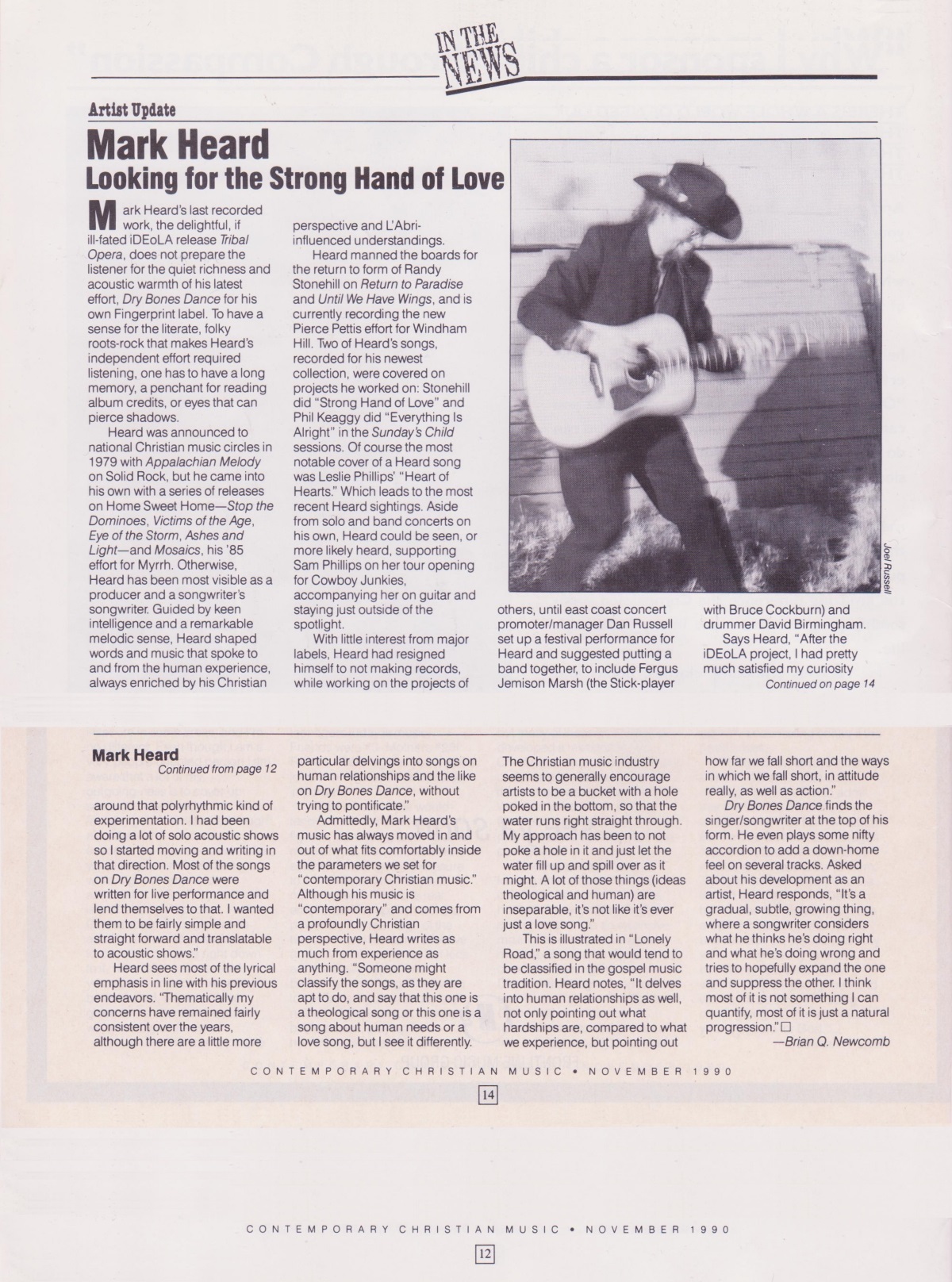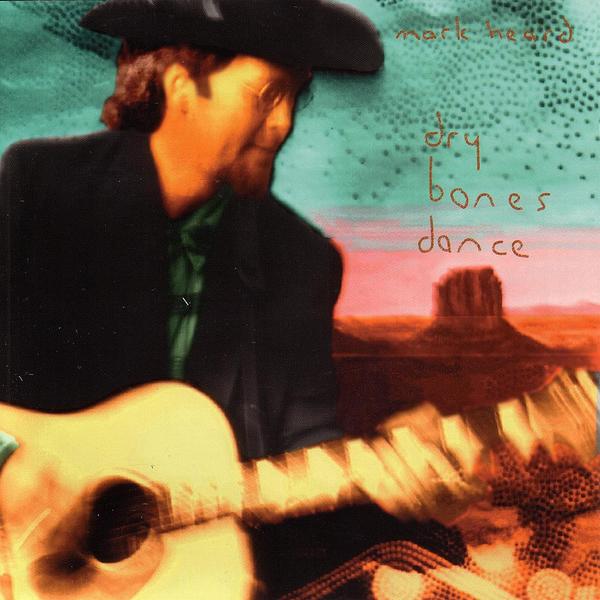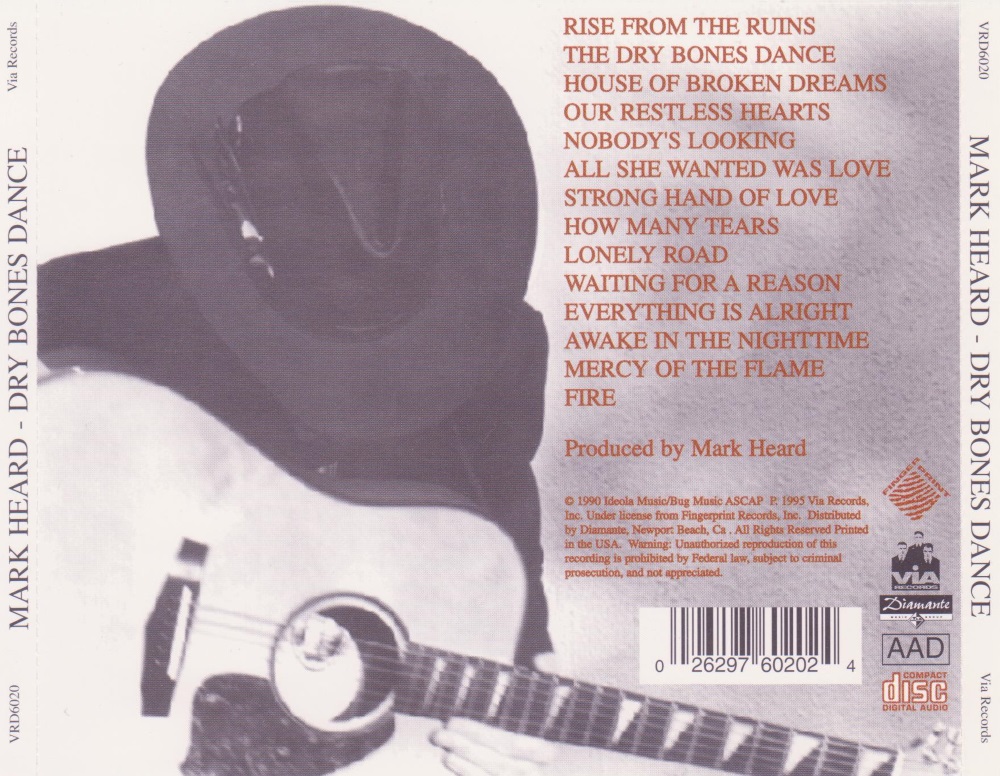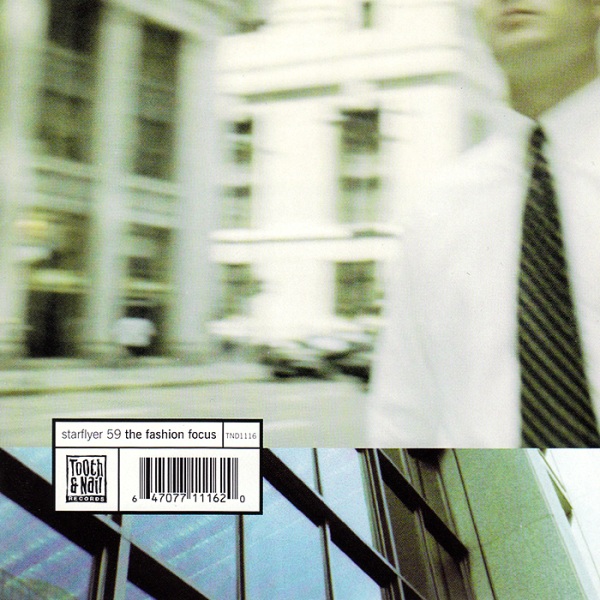Description
Dry Bones Dance is the eleventh studio album by the American singer and songwriter Mark Heard, independently released on his own label Fingerprint Records in March 1990, distributed by Spring Arbor. Also distributed in Europe by Myrrh/Word UK. The album was produced, recorded and mixed by Mark Heard at his own studio Fingerprint in Los Angeles, California; with basic tracks recorded at Plum Studios in Newburyport, Massachusetts. All songs written by Mark Heard. (The album track “Everything Is Alright” was actually first recorded by Phil Keaggy on his 1988-album, Sunday’s Child.)
Dry Bones Dance is the first of Mark Heard’s final trilogy of albums (Second Hand and Satellite Sky being the second and the last installments, respectively). His songwriting became as honest, seeking, truthful, and raw as it ever had been on these three final works. Most of the songs recorded on the first album were written for live performance and lend themselves to that. Heard wanted them to be fairly simple and straight forward and translatable to acoustic shows. On Dry Bones Dance, he revels in an earthy Americana that borders on twinges of country rock, complimenting the wry honesty of the lyrics. The sounds of the more traditional instruments really color this record well – the accordion, the mandolin, the violin, the hammered dulcimer – rich instrumental painting and texture. Powerful, emotional, truthful. The album could be considered kind of a tribute to the musical heritage of Heard’s hometown, Macon, located in the state of Georgia.
After the quick demise of What? Records, the short-lived label to release Mark Heard’s sole album as the one-man project iDEoLA, there was a gap of about three years during which time Heard had no label and no recording contract. With little interest from major record labels, Heard had resigned himself to not making records, while working on the projects of others, engineering and producing. (Heard engineered the re-mix album Adventures in the Land of Big Beats & Happy Feets under the pseudonym Lee Cahuenga, and engineered the multi-artist compilation Twelve New Faces, among other projects.) However he continued to write songs. In 1990 the independent label Fingerprint Records was founded by Heard, Dan Russell, as well as Heard’s long time friend from Macon, Chuck Long (who actually played on the first couple of albums recorded by Heard). Mark Heard’s songwriting was the focal point of Fingerprint, Russell was to provide the industry contacts and labor, and Long the financial backing.
To get Dry Bones Dance made, the first album for the new label, Russell essentially put a band together for Heard and almost forced him into a studio. Russell set up a little rehearsal studio in his barn, got together som very talented musicians (including Fergus Marsh, the Chapman Stick player for Bruce Cockburn), and then invited Heard to come out to New England to perform some of his new material. After several days rehearsing in the barn followed by a concert, Russell booked studio time. The basic tracks for Dry Bones Dance were recorded at Plum Studios in Newburyport, Massachusetts; with additional recordings done by Heard at his own studio in Los Angeles. Even though the label had little budget for advertising, word somehow got out and the album sold nearly 20,000 copies.
We didn’t really consider it a serious record, which really helped because you can get bogged down in those things. We just took an approach of ‘we don’t know what this is, and we don’t know if we’re going to-put it out or what.’ So for that reason, I think that it maintained a little life, and a little individuality that it probably wouldn’t have had if we got too serious about the whole thing and tried to make it into an album. [Mark Heard]
In the last ten years – give or take a couple – Mark Heard released a decade’s worth of brilliant albums. Although generally well-received by radio, and always meeting with critical acclaim, Heard’s records did not set the sales charts on fire. That, and his penchant for writing lyrics a bit more obtuse than major Christian labels would prefer, perhaps explains why Mark’s latest effort is on his own Fingerprint label. Although you may have to work a bit harder to obtain a copy, the search for Dry Bones Dance is well worth the effort. It’s one of the first great records of the 90’s, and the equal of Heard’s best ‘80s work, Victims of the Age.
Depending of how great your interest in alternative music, you would either have last spotted Mark on his own iDEoLA project, or caught a glimpse of him backing Sam Phillips on an acoustic club tour. Heard’s return to the studio is the antithesis of the iDEoLA disc; where it was a “one-man-band”, dance-oriented session of synthetic and sampled textures, Dry Bones Dance is entirely organic. Many of the basic tracks were performed “live” in the studio, and the most exotic thing you’ll hear is Heard’s kalimba (African percussion instrument plucked with fingers). The overall sound is acoustic-based, country-rock. Sometimes the songs veer in a Tex-Mex or Cajun direction, especially when Byron Berline starts sawing his fiddle and Heard joins in on an antique accordion. On other tracks, Heard harkens back to Rubber Soul-era Beatles, with delightful, chiming guitars, rich harmonies, and riffs that are instantly hummable. Heard has crafted 14 tracks which clock in at a generous 56:30 – and not a moment is wasted!
But Mark Heard’s superb songwriting is really at the core of Dry Bones Dance. Heard’s lyrics have often been described as literate, poetic, brutally honest and poignant. To that, I would add concise. There is no fat on these Dry Bones. Indeed, Heard may be contemporary Christian music’s best storyteller. With just five words – “penniless at the wishing well” – Heard conveys a feeling of utter brokenness. In «Our Restless Hearts», Heard spits out the lyrics “you smear the blame on me like cheap cosmetics” and goes on to admonish, “if there is love, then give me an example”. Heard turns in a great flat-picked, bluegrass lead guitar on the loping «Nobody’s Looking», and sings (in his slyest Dylan-ese) “You can pray if you want to / Go ahead, nobody’s looking but God”. «Everything is Alright» stresses the need for closeness with one’s mate, while «Lonely Road» reminds us that, no matter how tough we think we’ve got it, the Son of Man had it harder.
Dry Bones Dance has its harder moments as well. The rollicking «Waiting For A Reason», features a wonderful 12-string hook, and the closing, apocalyptic «Fire» combines all the instruments and voices in a glorious rock’n’roll stew. Heard is aided and abetted by several excellent musicians, most notably Fergus Marsh (of Bruce Cockburn’s band) on stick, Byron Berline on fiddle and mandolin, David Birmingham on drums, and Jerry Chamberlain, Sharon McCall, Pam Dwinell, and Sam Phillips on vocals. Perhaps at another time, we can debate why an artist of his calibre is forced to release recordings on his own custom label. For now, go out of your way to obtain Dry Bones Dance. (Sorry vinyl recluses, but it’s only available on cassette and compact disc). [Bruce Brown, CCM, June 1990]
Mark Heard has been around for years. Of course he originally came out of Larry Norman‘s camp along with Randy Stonehill and Tom Howard, and three or so years back made an unsuccessful pitch for crossover success with the synth-rock persona Ideola. Now he’s wisely returned to his roots and his latest is written, produced and engineered by himself, has fourteen songs and features accordion, fiddle, acoustic guitars and harmonica. Yep, truly more than a folk rock album. But don’t stop reading, it’s country that kicks gritty yet grooves, and no-one shouts out ‘yee-ha’ anywhere on the whole set. With touches of Leon Russell, Tom Petty and Dylan, Mark snarls his messages of woe and hope reaching deep within himself and pulling out nasal howls that erupt like a coyote on the night of a full moon. Acoustic guitar spits out riffs, the fiddle darts in and out and the occasional telecaster keeps us on the trail in true Jimmy Reed style. A lone female sings the harmony, drums and bass hold the arid atmosphere together. The texture of the music fits the themes of the songs perfectly. The cover pictures Mark with cowboy hat playing guitar in the open space of the prairie. The first song «Rise From The Ruins» speaks of the resurrection of humankind capturing the feel of dust to dust. The title song «Dry Bones Dance» continues the theme. Moody…raw…well worth parting with your £6.49 [Paul Poulton, Cross Rhythms, Nov/Dec 1990]
> Apple Music (https://music.apple.com/us/album/dry-bones-dance/262311153)
CD tracklist:
01. Rise From The Ruins – 3:02
02. The Dry Bones Dance – 3:46
03. House Of Broken Dreams – 4:11
04. Our Restless Hearts – 3:42
05. Nobody’s Looking – 3:26
06. All She Wanted Was Love – 4:19
07. Strong Hand Of Love – 3:03
08. How Many Tears – 2:58
09. Lonely Road – 4:12
10. Waiting For A Reason – 3:30
11. Everything Is Alright – 4:24
12. Awake In The Nightime – 3:29
13. Mercy Of The Flame – 4:58
14. Fire – 7:13
Note: Simultaneously released on cassette and CD by Fingerprint Records. Re-issued by VIA Records in 1995, distributed by Diamante. Remastered and re-issued as a Deluxe 2CD by Lo-Fidelity Records in 2021, through a IndieGoGo-funded campaign. As well released on vinyl as a 180 gram double LP set fully remastered for vinyl, housed in a full color gatefold jacket with insert. (Pressed on Black, Orange/Red “Smoke”, Blue/Orange “Smash”, as well as Pinwheel Splatter 12-inch vinyl.) Available at Bandcamp: https://markheard.bandcamp.com/album/dry-bones-dance-2021-remaster
VARIOUS COVERS
[responsive_vimeo 482366279]Mark Heard Indiegogo
 An interview with Mark Heard regarding his new, self-released album, Dry Bones Dance, was featured in the November 1990 issue of CCM Magazine.
An interview with Mark Heard regarding his new, self-released album, Dry Bones Dance, was featured in the November 1990 issue of CCM Magazine.
CREDITS. Produced by Mark Heard. Recorded and Mixed at Fingerprint, Los Angeles by Mark Heard. Basic tracks recorded at Plum Studios, Newburyport, Massachusetts. Second Engineers: Joel Russell, Richard Tiegen, Dan Reed, David Miner, Tom Willett. Digital Mastering by Dennis Bouch at Futuredisc Systems. Associate Producer: Dan Russell. Executive-at-large: Chuck Long. Wagonmaster: Joel Russell. Occasional back-seat driving: Tom Willett. Photography by Joel Russell. Graphic Art by Tim Alderson and Tom Goosmann of Tim Alderson Design. All songs written by Mark Heard.
Musicians: Mark Heard (Lead Vocals and Assorted Backing Vocals, Acoustic and Electric Guitars, Accordian, Harmonica, Kalimba), Michael Been (Guitar Solo on “Lonely Road”), Byron Berline (Fiddle, Mandolin), Doug Berch (Hammered Dulcimer), Novi (Viola), Fergus Marsh (Chapman Stick), David Birmingham (Drums). Backing Vocals: Sam Phillips (3,4,8,12), Pam Dwinell (1,2,7,9), Jerry Chamberlain and Sharon McCall (11,13,14).






Reviews
There are no reviews yet.